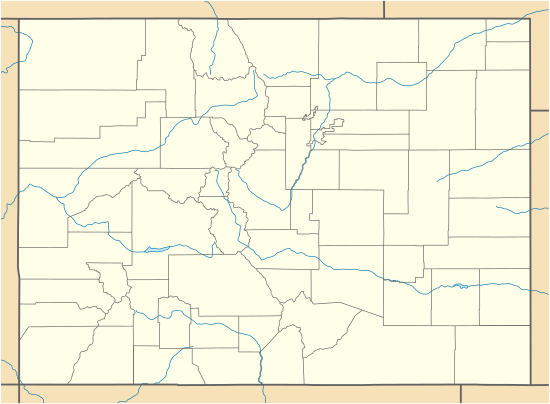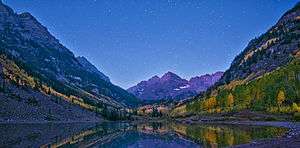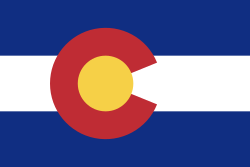Maroon Bells
The Maroon Bells are two peaks in the Elk Mountains, Maroon Peak and North Maroon Peak, separated by about half a kilometer (one-third of a mile).[5] The mountains are on the border between Pitkin County and Gunnison County, Colorado, United States, about 12 miles (19 km) southwest of Aspen. Both peaks are fourteeners. Maroon Peak, at 14,163 feet (4317 m), is the 27th highest peak in Colorado. North Maroon Peak, at 14,019 feet (4273 m), is the 50th highest (depending on how they are counted). The view of the Maroon Bells to the southwest from the Maroon Creek valley is very heavily photographed. The peaks are located in the Maroon Bells–Snowmass Wilderness of White River National Forest.[6][7] Maroon Bells-Snowmass Wilderness was one of five areas in Colorado designated as wilderness in the original Wilderness Act of 1964. The Wilderness area surrounds the extremely popular Maroon Bells Scenic Area, which is a major access point for Wilderness travel.[8]
| Maroon Bells | |
|---|---|
a.jpg) Maroon Bells | |
| Highest point | |
| Peak | Maroon Peak |
| Elevation | 14,163 ft (4,317 m) [1][2] NAVD88 |
| Prominence | 2336 ft (712 m) [3] |
| Isolation | 8.06 mi (12.97 km) [3] |
| Listing | |
| Coordinates | 39°04′15″N 106°59′20″W [1] |
| Geography | |
 Maroon Bells | |
| Location | Gunnison and Pitkin counties, Colorado, United States[1] |
| Parent range | Elk Mountains[4] |
| Topo map | USGS 7.5' topographic map Maroon Bells, Colorado[1] |
| Climbing | |
| First ascent | 1890s by C. Wilson |
| Easiest route | Exposed scramble, class 4 |
Geology

Unlike other mountains in the Rockies that are composed of granite and limestone, the Bells are composed of metamorphic sedimentary mudstone that has hardened into rock over millions of years. Mudstone is weak and fractures readily, giving rise to dangerously loose rock along almost any route. A US Forest Service sign on the access trail warns would-be climbers of "downsloping, loose, rotten and unstable" rock that "kills without warning". The mudstone is also responsible for the Bells' distinctive maroon color. The Bells got their "deadly" reputation in 1965 when eight people died in five separate accidents.
Maroon Lake elevation 9,580 ft (2,920 m) occupies a basin that was sculpted by Ice-Age glaciers and later dammed by a landslide and rockfall debris from the steep slopes above the valley floor.
Recreation
The Maroon Bells are an increasingly popular destination for the day and overnight visitors; around 300,000 people visit the Bells every season.[9] Due to the large volume of visitors, a bus service runs every day from 8am-5pm from mid-June through the first weekend in October. During these times, and with just a few exceptions, personal vehicle access is limited to those with handicap placards or disability license plates. The bus runs from Aspen Highlands to Maroon Lake every 20 minutes. The Maroon Bells scenic area features several hiking trails ranging from short hikes near Maroon Lake to longer overnight backpacking trips into the Maroon-Snowmass Wilderness.[10][11] Not only is the use of trails and other outdoor recreational space growing, the overall population of Colorado is growing as well. It is expected that 100,000 people will move to Colorado each year for the next two decades.[12] By 2050, the population of Colorado is expected to increase from 5.5 million to 8.5 million,[13] and with this population growth recreational tourism will continue to grow. In 2017, 1 in 4 of Colorado's 86 million visitors spent most of their trip in mountain towns and resorts.[14] This rapid growth poses challenges for Forest Services to properly maintain natural areas, and if changes are not made to how the recreational space is utilized, wilderness areas like the Maroon Bells–Snowmass Wilderness trails will feel the impacts of human traffic.
Preservation
Because the Maroon Bells area receives such high levels of visitor use, the USFS has established a long-term plan to protect and preserve the scenic area and larger wilderness areas. Solutions include the required use of bear canisters for backcountry campers, management of day and overnight use, leashed dog education and ticketing, reduction of heavy horse use in high use areas, and prohibiting overnight camping and excessive day use at particular sites.[15] Recently, the US Forest Service (USFS) has come up with a paid permit plan to aid preservation efforts. The permit system was created to allow visitors to stay overnight while mitigating environmental damage and preserving the highly visited area. A permit is required year-round, and limits campers to stay in the Conundrum Creek Valley area from Silver Dollar Pond to Triangle Pass.[16] Campsite limits range from 2 to 6 people, depending on the campsite location. The USFS limits the number of permits to 2 permits per person per calendar year and the maximum stay from June 1- September 1 is 3 nights; the maximum stay for the rest of the year is 7 nights.[17] The Conundrum Hot Springs alone can attract up to 300 people a night.[18]
.jpg)
Environmental Impacts
Specific environmental impacts can occur due to the high number of visitors the Maroon Bells experiences each year. See below for more information.

Water pollution
The Maroon Bells Recreation area is surrounded by Maroon Creek, which feeds into Crater Lake and Maroon Lake. These natural freshwater ecosystems fill from snowmelt from the surrounding peaks and precipitation, and are major sources of water for the city of Aspen,CO.[19] According to the study Environmental Impacts of Tourism on Lakes,[20] water pollution can occur through indirect and direct methods. Direct pollution to these natural bodies of water occurs when visitors choose to wade or throw items into these bodies of water, disrupting the fragile biodiversity. An increase in human-traffic,such as the increase in the number of visitors who drive up Maroon Creek Road, is an example of indirect pollution. This constant vehicular traffic releases pollutants such as nitrogen and sulfur dioxide into the water and air.
.jpg)
U.S. Forest Service officials were concerned about the high nitrogen compound levels in the waters at the Maroon Bells in 2003.[21] Officials mentioned that the increase in population and recreation in Colorado as well as an increase in the number of vehicles could be a cause of the elevated nitrogen compound levels, as these sources emit pollutants. When precipitation forms over peaks like the Maroon Bells, these pollutants fall back to the Earth's surface and can travel into the river and lakes, harming fish, insects, and plants, particularly because of high levels of nitrogen. The U.S. Environmental Protection Agency further supports the relationship between pollutants and their negative impacts on lakes, streams, and rivers.[22]
Trail erosion
Another impact of overcrowding in the Maroon Bells trail erosion due to the overwhelming number of visitors. High-traffic hiking can lead to negative environmental outcomes such as “soil disruption, loss of native plant species, vegetation, introduction of weeds and pathogens.”[23] Maroon Bells offers several trails for day-use as well as overnight use; however, many visitors that see the Maroon Bells will make the trek on popular trails surrounding Maroon and Crater Lake. When hikers stray from these highly trafficked trails, they end up establishing “social trails.” These hiker-created trails are not designed to be sensitive to the fragile ecosystem, and often further hurt the natural beauty of the area by damaging vegetation. A recent project to "rope off" sensitive areas to prohibit social trails was implemented in 2018 well.[24]

Human waste
With an increase in human traffic on trails and in wilderness areas, human waste has become a serious issue.[25] Areas surrounding Condunrum Hot Springs, the Maroon Bells, and the Maroon-Bells Wilderness area has dealt with visitors not practicing proper human waste disposal. Besides the foul smell, human waste can contaminate local water systems and spread disease.[26] It is necessary to use facilities when available as human waste can contain harmful bacteria that can put populations at risk if exposed to it. For those visitors who go further into the backcountry, taking necessary steps to reduce this contamination is critical. In addition to this report, the book Colorado Recreation Guide, Arapaho and Roosevelt National Forests mentions the importance of if an individual must “go in the woods” to make sure to stay away from vegetation as the acidity in urine can impair plant growth.[27]
In an attempt to mitigate some of the human waste concerns, the Forest Service recently implemented a human waste awareness campaign (launched around the same time as the paid permit plan). The awareness campaign included educational information on responsible waste disposal (including how to dig cat holes to dispose human feces) as well as the allocation of free portable toilets, called “wag bags,” for all visitors. The Forest Service announced a decline in improperly disposed human waste since the campaign began; however, it is important to continue these efforts.[28]

Noise pollution
Noise pollution is defined as “regular exposure to elevated sound levels that can be adverse in humans and other living organisms”,and can have negative impacts on the environment and wildlife.[29] With an increased number in visitors,noise pollution has become a concern when visiting the Maroon Bells. According to a study done by the Department of Fish, Wildlife, and Conservation Biology at Colorado State University in 2017, noise can alter communication between wildlife and insects as well as change their behaviors and patterns.This study also found that noise pollution can disrupt organisms that play a role in pollination as these animals can hear and are impacted by the noise.[30]
Human Impacts
Studies have shown increased levels of pharmaceutical elements (for example, insect repellant), hormones, and related chemicals in waterways downstream from areas of high backpacker use. Additionally, a 2016 study of water and sediment samples from wilderness areas in Colorado found notable levels of anthropogenic bioactive chemicals, which indicates human sources of contamination. This contamination can become a danger to human health, especially during summer storm season, as water flows into sources that are used for human consumption – both within the wilderness area and in downstream communities such as Aspen, CO – and agriculture.[31]

Campsites set up by backcountry backpackers can also lead to soil compaction and reduced vegetative cover, especially in wilderness areas. Higher erosion levels can occur in the backcountry if backpacker campsites are not properly set-up and taken down. This can cause an increase in water turbidity and some water quality indicators including a strain of E.Coli; further supporting higher erosion level from degraded soils.[32]
Time spent in the outdoors, including engaging in activities such as hiking, has been shown to have a positive impact on human health. By being active in the outdoors, people can experience health benefits ranging from increased Vitamin D levels to lower rates of obesity; improvements in mental health, such as reduced levels of depression have also been observed.[33] However, trail overuse and overcrowding can affect these benefits. Indeed, experiential sentiments such as solitude, remoteness, naturalness, and artifactualism are often cited key benefits of time spent in the outdoors. However,overcrowding threatens this positive experience.[34] Some have noted that environmental health and human health are deeply intertwined, and, as such, should be duly protected and sustained.[35]
Addressing these Issues
Trail education and much needed enforcement of regulations established to protect this popular destination can help address these human and environmental impacts. Below are a few key ways that we can protect Maroon Bells going forward.
- Camp in designated campgrounds: While camping is prohibited at many of the high-mountain lakes in the Maroon Bells-Snowmass area, the United States Forestry Service (USFS) has inventoried 700 campsites for recreational use.
- Keep out of water: Drinking or going in the lake water is not recommended for the protection of the ecosystem, as well as health reasons.
- Clean up Trash: “No trace left behind” was an impactful awareness campaign that created a buzz about the importance of cleaning up all trash (varying from human/dog waste to leftover foods or paper goods).
- Stay on designated trail:Remaining on the trail keep hikes and backpackers safe from wildlife, and also protects off-trail vegetation.
- Reduce Carbon Footprint:Opt to take alternative transportation such as the shuttles provided by the City of Aspen when you visit the Maroon Bells.
.jpg) Maroon Bells Bus - Aspen, Colorado (45114811752)
Maroon Bells Bus - Aspen, Colorado (45114811752)
See also


- List of Colorado fourteeners
References
- "MAROON PEAK". NGS data sheet. U.S. National Geodetic Survey. Retrieved January 6, 2016.
- The elevation of Maroon Peak includes an adjustment of +2.048 m (+6.72 ft) from NGVD 29 to NAVD 88.
- "Maroon Peak, Colorado". Peakbagger.com. Retrieved January 6, 2016.
- "Maroon Peak". Geographic Names Information System. United States Geological Survey. Retrieved October 29, 2014.
- "Maroon Bells Wilderness, Colorado". NASA. 2007-10-21.
- "Maroon Bells-Snowmass Wilderness". Wilderness.net. Archived from the original on July 1, 2012. Retrieved August 11, 2012.
- "Maroon Bells-Snowmass Wilderness Area". Colorado Wilderness. Retrieved August 11, 2012.
- "Maroon Bells-Snowmass Wilderness - White River". United States Forest Service. Retrieved 28 February 2019.
- Scott Condon (November 29, 2017). "Record 320,500 visitors surge to Aspen's Maroon Bells". Aspen Times.
- "Hiking Guide to Maroon Bells Colorado". Dayhikes Near Denver. 19 March 2016. Retrieved 19 March 2016.
- "Four Pass Loop, Maroon Bells-Snowmass Wilderness". Backpackers Review. 2019-05-08. Retrieved 9 May 2019.
- "Colorado's Outdoor Recreation Industry Continues Economic Growth". Denver Channel. Denver. 2019-01-03. Retrieved 11 March 2019.
- "SCORP report" (PDF). Colorado Parks and Wildlife. Colorado Parks and Wildlife. Retrieved 12 March 2019.
- "Colorado tourism record in 2017 in mountain towns and resorts". Denver Post. Denver Post. 2018-06-28. Retrieved 11 March 2019.
- "Wilderness Education Plan Maroon Bells-Snowmass Wilderness Aspen – Sopris and Gunnison Ranger District". United States Forest Service. USFS. Retrieved 19 March 2016.
- "Permits". Recreation.gov. Recreation.gov. Retrieved 10 March 2019.
- "Conundrum Hot Springs Maroon-Bells Wilderness Area". Recreation.gov. Recreation.gov. Retrieved 11 March 2019.
- "Conundrum Hot Springs Has a Poop Problem So You May Have To Bag Your Business". Colorado Public Radio. Colorado Public Radio. Retrieved 12 March 2019.
- "City of Aspen". cityofaspen.com. cityofaspen. Retrieved 7 March 2019.
- "Environmental Impacts of Tourism on Lakes". ResearchGate. Springer Science+Business Media Dordrecht. Retrieved 7 March 2019.
- "Pollutants may be changing wilderness ecology". Aspen Times.com. AspenTimes. Retrieved 7 March 2019.
- "Clean Air Act Overview". Environmental Protection Agency. Enivronmental Protection Agency. 2015-06-08. Retrieved 7 March 2019.
- Pickering, C. M.; Hill, W.; Newsome, D.; Leung, Y. F. (2010). "Comparing hiking, mountain biking and horse riding impacts on vegetation and soils in Australia and the United States of America". Journal of Environmental Management. 91 (3): 551–62. doi:10.1016/j.jenvman.2009.09.025. PMID 19864052.
- "Maroon Lake Project to rope off area is effort to end social trails near maroon-bells". AspenTimes.com. AspenTimes. Retrieved 7 March 2019.
- "2016 Wilderness Program Report" (PDF). Aspen Sopris Ranger District White River National Forest. Aspen Sopris Ranger District. Retrieved 7 March 2019.
- "Leave No Trace". Leave No Trace Center for Outdoor Ethics. Leave No Trace Center for Outdoor Ethics. Retrieved 12 March 2019.
- Outdoor Books & Maps (Firm) (1995). Colorado Recreation Guide, Arapaho & Roosevelt National Forests. Adler Publishing. p. 37. ISBN 978-0-930657-08-6.
- "Now That Permits Are In Place, Conundrum Hot Springs Feels A Little Cleaner". Colorado Public Radio. Colorado Public Radio. Retrieved 13 March 2019.
- "Noise Pollution". Environmental Pollution Centers. Environmental Pollution Centers. Retrieved 8 March 2019.
- "Noise created by humans is pervasive in US protected areas". Colorado State University Source. Source. 2017-05-04. Retrieved 8 March 2019.
- "Aerobic biodegradation potential of endocrine disrupting chemicals in surface-water sediment at Rocky Mountain National Park". Pubmed.gov. Environmental toxicology and chemistry. Retrieved 10 March 2019.
- Forrester, H.; Clow, D.; Roche, J.; Heyvaert, A.; Battaglin, W. (2017). "Effects of Backpacker Use, Pack Stock Trail Use, and Pack Stock Grazing on Water-Quality Indicators, Including Nutrients, E.coli, Hormones, and Pharmaceuticals, in Yosemite National Park, USA". Environmental Management. 60 (3): 526–543. Bibcode:2017EnMan..60..526F. doi:10.1007/s00267-017-0899-z. PMID 28597051.
- Mitten, D.; Overholt, J. R.; Haynes, F. I.; d'Amore, C. C.; Ady, J. C. (2018). "Hiking: A Low-Cost, Accessible Intervention to Promote Health Benefits". American Journal of Lifestyle Medicine. Sage Journals. 12 (4): 302–310. doi:10.1177/1559827616658229. PMC 6993091. PMID 32063815.
- Lynn, Natasha A.; Brown, Robert D. (2003). "Effects of recreational use impacts on hiking experiences in natural areas" (PDF). Landscape and Urban Planning. ScienceDirect. 64 (1–2): 77–87. doi:10.1016/S0169-2046(02)00202-5. hdl:10214/4029.
- "Greening Health:The Role of Parks, Recreation, and Tourism in Health Promotion". Researchgate. Journal of Park and Recreation Administration. Retrieved 10 March 2019.
External links
| Wikimedia Commons has media related to Maroon Bells. |
